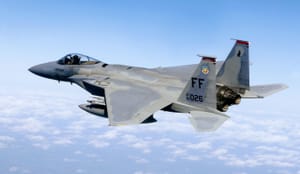
Nov 28, 2023
The F-15 - The best fighter jet ever.
Disclaimer: This article contains the opinion of the writer and not Cosmic Nxws as a whole.
Additional Disclaimer: Information on some variants may have been released after the publication of this article due to the national security nature of the F-15. Some necessary information may also not be available.
The F-15 'Eagle', including its variants and derivates, is arguably one of the most recognizable aircraft ever made. The United States Air Force F-15 'Eagle' is a twin-engine tactical fighter aircraft that first flew in July of 1972 and entered service with a combat squadron in January 1976.
The F-15 was initially developed as an air superiority fighter aircraft to surpass the Soviet MiG-23 and match the Mig-25 in capabilities. The F-15 today has three major variants; F-15E 'Strike Eagle', F-15 STOL/MTD, and F-15J. All will be covered in this article.
Some notable achievements and fun facts of the F-15s are the following. Of the believed 1,900 built to date (November 2023) zero have been lost in combat with one-hundred and four recorded kills. With three external fuel tanks, the potential range is increased to 3,450 miles, or just enough range to cross from the United States to England without refueling. The top speed is assumed to be Mach 2.4, or 1,770 miles per hour, with a thrust-to-weight ratio of 1.19 during missions. The F-15K from the Republic of Korea, South Korea, however, has an alleged thrust-to-weight ratio of 1.29!
The F-15 is also the only aircraft known to have a confirmed air-to-space kill using an ASM-135 ASAT missile mounted underneath the aircraft. To achieve the air-to-space kill the pilot, Wilbert Pearson, claimed to 30,000 feet over three hours and then lit the aircrafts afterburners and accelerated to Mach 1.3 while in a sixty-degree climb. Once in the climb, the F-15 was slowed to Mach 0.96 to release the missile and proceeded to shoot down the P78-1, Solwind, satellite.
With improvements in modern variants, it is likely the F-15 will be flying in service by the 2030s and potentially the 2040s worldwide.

Following that, here are some of the interesting variants of the F-15 and a wild proposal from Boeing in 2006.
F-15E & Variants
The F-15E is a multirole strike fighter derived from the F-15 for high-speed interdiction which has seen action in Iraq, Libya, Syria, and Afghanistan. Born from the United States Air Force Enhanced Tactical Fighter program, the F-15E entered service in September 1989 and is still in service today with The United States, Saudi Arabia, Israel, Singapore, Qatar, and South Korea. Boeing boasts the F-15E as having a service ceiling of sixty thousand feet, a combat range of almost eight hundred miles, a top speed of 1,650 miles per hour, and a max range of 2,400 miles.

F-15K
The F-15K 'Slam Eagle' is the South Korean operated version of the F-15E. South Korea is responsible for forty percent of its production along with twenty-five percent of its total assembly.

Some notable features of the F-15K are; an AAS-42 Infra-red search and track system for a customized Tactical Electronics Warfare Suite to reduce weight and increase jamming, compatibility of night vision devices in the cockpit, and an APG-63(V)1 mechanical-scanned array radar among others.
F-15QA
The Qatar Emiri Air Force operates the F-15QA after buying one-hundred and eight of them over five years for roughly 36.8 billion United States dollars. In June 2021 it was announced that the F-15QAs would begin being equipped with Elbit Systems anti-jamming systems to allow it to fly into heavy electromagnetic interference environment uninterrupted.

F-15 STOL/MTD
The F-15 Short Takeoff and Landing/Maneuver Technology Demonstrator is a modified version of the F-15 'Eagle' operated by the United States Air Force and NASA for studying the effects of enhanced maneuverability and thrust vectoring.

The F-15 Short Takeoff and Landing/Maneuver Technology Demonstrator was part of a program of the same name and helped test methods for operating from a short runway. Some notable achievements of this F-15 are; demonstrating a takeoff speed as low as forty-two miles per hour, producing reverse thrust for 'rapid deceleration', and landing on a 500-meter runway instead of the 2,300-meter runway for a normal F-15.
Only one Short Takeoff and Landing/Maneuver Technology Demonstrator F-15 was built and was retired in January 2009. Today it is on display at Edwards Air Force Base.
F-15J
The F-15J 'Eagle' like other F-15s is an all-weather air superiority fighter based on the original F-15. The F-15J however is produced under license by Mitsubishi Heavy Industries for use with the Japan Air Self-Defense Force. Japan and its self-defense forces are also the largest customer for the F-15 outside of the United States.

There are two versions of the F-15J being; the F15J which is a single-seat all-weather air-superiority fighter for the Japan Air Self-Defense Force with one-hundred and fifty-five in service, and the F-15DJ which is a Two-seat training version for the Japan Air Self-Defense Force with forty-five in service.
F-15EX
The F-15EX 'Eagle II' is a modernized version of the F-15E being produced since 2021. The United States Air Force bought the F-15EX due to an end of production for the F-22 'Raptor' and the F-35 being behind schedule.

The F-15EX is advertised by Boeing as being able to enforce no-fly zones, perform homeland defense, and deploy 'standoff weapons'. All using a fourth-generation aircraft platform into the 2030s. The United States Air Force currently plans to operate one-hundred and four F-15EXs.
The F-15EX will potentially see use in Thailand, Israel, and Indonesia.
F-15 GSE - A wild idea
In 2006 Boeing proposed the F-15 'Global Strike Eagle', a wild plan for an unmanned version of the F-15E with either a missile or orbital launch vehicle mounted on top of the aircraft (pictured below).

The concept from Boeing proposed the F-15 'Global Strike Eagle' as a low-cost demonstration of global strike capability utilizing a variety of munitions. It was promoted as providing a low Earth orbit launch capability for microsatellites and CubeSats. There was also a potential upgrade path for delivering heavier ballistic and orbital payloads.
The 'Global Strike Eagle' planned to use 'off-the-shelf solid rocket motors' to reduce time, cost, and complexity. The first stage would use an SR-19 solid motor from the Minutemen II as a first stage, an Orion 50 XL solid motor from the Pegasus XL as the second stage, and an Orion 38 solid motor as the third stage. The launch vehicle would have four aerodynamic control surfaces for boost phase control and a cone on the aft of the rocket to reduce drag while attached to the F-15 'Global Strike Eagle'. The planned setup for the launch vehicle is attached below.

The claimed benefits of the F-15 'Global Strike Eagle' were; low system development costs, responsive space and munitions launch capability, low profile mission as it looks like other F-15s, and potential upgradable system capabilities.



